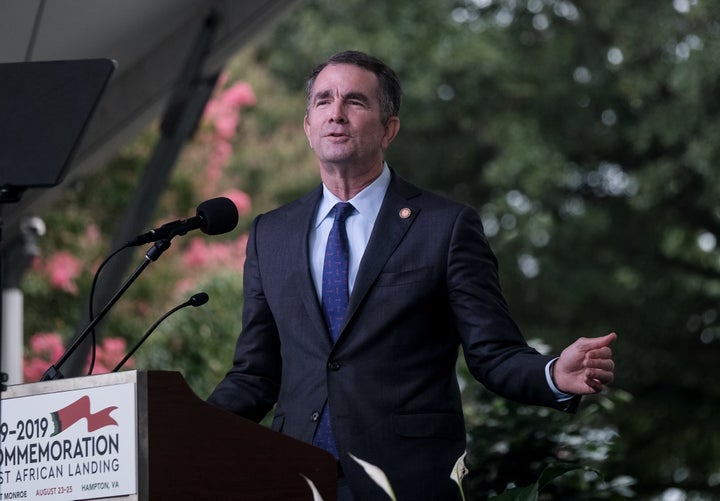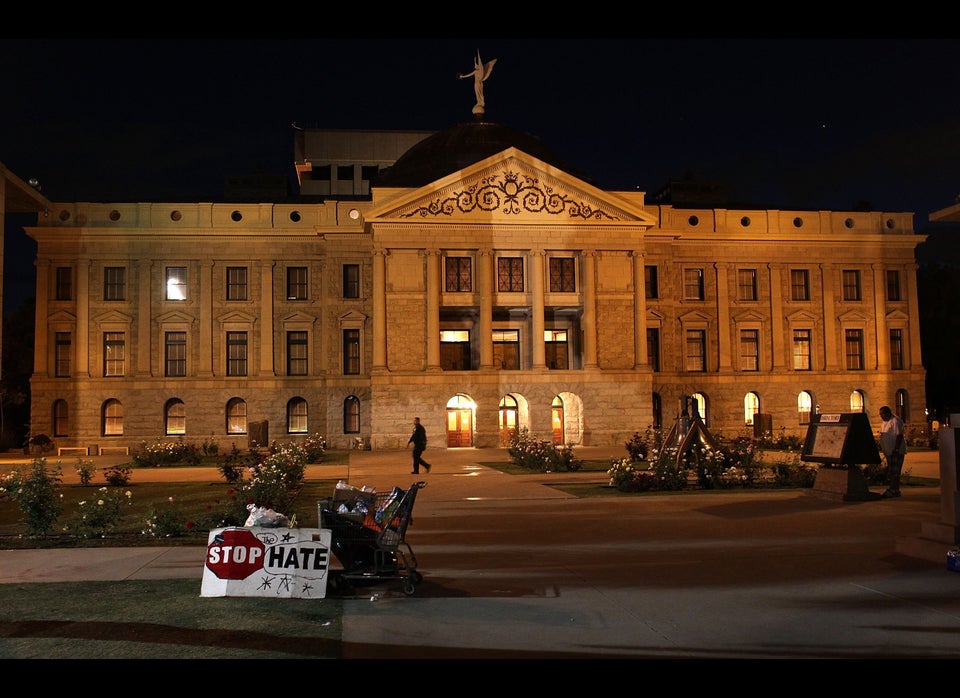Virginia Gov. Ralph Northam (D) all but ruled out repealing the state’s anti-union “right-to-work” law on Monday, dashing the hopes of a rising populist guard that is hoping to bring Virginia in line with other solidly Democratic states where organized labor flourishes.
A Northam spokesperson did not immediately respond to HuffPost’s request for clarification of the governor’s intentions, including whether he would veto a repeal bill if it arrives on his desk.
Regardless, Northam’s remarks that he cannot “foresee” Virginia rescinding the law, delivered alongside outgoing Republican legislative leaders at a state economic and revenue forecast meeting, discouraged unions and progressives eager to see Democrats both reembrace their historic solidarity with organized labor and enact policy with an eye toward the party’s long-term political fortunes.
“Today is a disappointing day for the working-class families of Virginia,” said William Sproule, executive secretary-treasurer of the Keystone-Mountain-Lakes Regional Council of Carpenters, which represents union carpenters in Virginia.
Unions have greater difficulty organizing and maintaining power in “right-to-work” states because those states bar unions from collecting dues from workers they represent in front of management. As a result, some workers choose to “freeload,” or benefit from the union’s protection without contributing, which typically limits a union’s financial resources.
Right-to-work policy “has succeeded in its purpose: The wage levels for working people in the state of Virginia are appalling,” said Chris Townsend, the organizing director of the Amalgamated Transit Union, who has lived in Alexandria, Virginia, for the past 30 years.

There is research to support Townsend’s claim. Right-to-work states, which are almost all outside the pro-union Northeast and West Coast, have wages that are, on average, 3.1% lower than pro-union states, according to a 2015 study by the liberal Economic Policy Institute.
That’s true not just because of the direct benefits of unionization for workers, but also because the threat of unionization prompts employers in pro-union states to offer better pay and benefits to stave off unionization.
“Allowing unions to be effective promotes the wages of not just union members, but non-union members as well,” said Jeff Hauser, a former AFL-CIO spokesman who now runs the Center for Economic and Policy Research’s Revolving Door Project.
Virginia, where elections earlier this month handed Democrats unified control of the state government, gets particularly low marks when it comes to workers’ rights. The human rights nonprofit Oxfam ranked Virginia dead last in its ranking of the “best places to work in America.”
In addition to being a right-to-work state, Virginia bars public-sector workers ― those employed by the state, counties and municipalities ― from engaging in collective bargaining.
“In Virginia, we can not only win by being a good state for business, but we can also win by being one of the best states for workers.”
- Del. Jennifer Carroll Foy (D)
Del. Jennifer Carroll Foy (D), a public defender representing the outermost suburbs of Northern Virginia, still hopes to pass legislation overturning the right-to-work law. She noted that Del. Lee Carter (D), a democratic socialist from Manassas, has vowed to introduce repeal legislation.
“In Virginia, we can not only win by being a good state for business, but we can also win by being one of the best states for workers,” Carroll Foy said. “Many other states have done this.”
A spokesperson for Democratic Speaker-designate Eileen Filler-Corn did not immediately respond to HuffPost’s inquiry about whether Filler-Corn would allow such a bill to proceed out of committee for a vote on the House floor.
To those familiar with Northam, a business-friendly physician who says he voted twice for President George W. Bush, Monday’s indication that he would not rescind the state’s right-to-work law was not altogether surprising. He’d even reportedly said something similar to union officials in a private meeting before state elections earlier this month.
But even his detractors are disappointed in Northam’s insensitivity to the political implications of allowing his state to remain inhospitable to unions.
Republican lawmakers, by contrast, are keenly aware of the political advantages of kneecapping unions. In the past decade, in particular, Republican governors have moved rapidly to gut labor unions, knowing that they engender class consciousness at odds with GOP ideology and funnel money and resources to Democratic candidates. Here again, there is research to back up Republicans’ conduct: In presidential races, Democratic vote share by county drops 3.5 percentage points after passage of right-to-work laws, according to a National Bureau of Economic Research study published in February.
“The right tries to use temporary power to build permanent power for its coalition and erode the power of the opposing coalition.”
- Jeff Hauser, former AFL-CIO spokesman
The most glaring example of Republicans riding anti-union legislation to victory at the ballot is Wisconsin, where former Gov. Scott Walker (R) stripped public-sector unions of key bargaining rights and later made Wisconsin a right-to-work state, denuding private-sector unions in the process.
On election night in 2016, conservative anti-tax crusader Grover Norquist gloated that Walker’s evisceration of his state’s unions had won the state for Donald Trump.
Michigan, home to the country’s unionized auto industry, underwent a quieter transition to right-to-work status in 2012. Democratic nominee Hillary Clinton also narrowly lost that state to Trump in 2016.
“The right tries to use temporary power to build permanent power for its coalition and erode the power of the opposing coalition,” said Hauser, noting not just Republicans’ prioritization of attacks on unions, but also their efforts to restrict voting rights that disadvantage traditionally Democratic demographic groups.
Short of Republican-style voter disenfranchisement, Hauser recommended that Democrats “also learn to prioritize acts that expand the ongoing power of their coalition,” including by creating conditions for unions to flourish.
A perennial source of frustration for opponents of anti-union laws is that Republicans typically do not emphasize them during campaigns and then railroad them through at the first chance once in office.
Given the opportunity to weigh in, the voting public, even in conservative states, often overturns such laws. Most recently, Missouri voters threw out a right-to-work law through a statewide ballot initiative in August 2018.
Virginia voters have a record of similar action. In November 2016, state residents voted down a referendum that would have enshrined the state’s right-to-work status in its constitution.
Sproule of the carpenters union cited the 2016 outcome, as well as the victory of pro-union Democrats in 2019, in his statement.
“Northam has changed views on this important issue, but the Keystone-Mountain-Lakes Regional Council of Carpenters [has] not,” he said.
Of course, even if Northam, who survived public uproar in February over the revelation that he’d worn blackface as a medical student, got out of the way of a right-to-work repeal effort, some of the Democrats in the state legislature would likely need some convincing. Particularly in the state Senate, many veteran Democrats embody the tradition of bipartisan chumminess with big business that is sometimes dubbed the “Virginia Way.”
There are some signs that the tides are shifting toward a more populist iteration of the Democratic Party ― albeit slowly. The rise of a vibrant liberal grassroots movement in Virginia after Trump’s victory in 2016 ushered in a crop of “Virginia Way” skeptics to the state Capitol. These younger, more diverse and more progressive lawmakers, mostly in the House of Delegates, have had some success in reining in the state’s influential electric utility monopolies.
But a bid by House progressives to elect one of their own as speaker fell short earlier this month.
For Townsend, the transit union official, the mere discussion of right-to-work laws ― and public pushback against Northam ― is a harbinger of change.
“We didn’t have that for years and years,” he said. “There’s only one way to go in Virginia, which is up ― so what the hell.”


